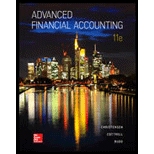
Concept explainers
Bonds of affiliate purchased from non-affiliate: When an affiliate of issuer later acquires bonds form unrelated party, the bonds are retired at the time of purchase. The bonds are not held outside the consolidated entity once another company within the consolidated entity purchases them, it must be treated as repurchase by debtor. Acquisition of an affiliate’s bonds by another company with in affiliated entities is referred as constructive retirement. Although bonds are not actually retired.
When constructive retirement occurs the consolidated income statement reports gain or loss based on difference between carrying value and purchase price paid by affiliate to acquire it. And it is not reported in consolidated
To explain : what will be the effect on consolidated net income and income to the controlling interest, when a subsidiary purchases the bonds of its parent from a non-affiliate for less than the book value.
Want to see the full answer?
Check out a sample textbook solution
Chapter 8 Solutions
Advanced Financial Accounting
- A parent business purchases bonds on the open market that had previously been issued by a subsidiary of the parent firm. Consequently, the price paid by the parent is less than the amount of bonds that are currently recorded on the subsid- iary's books. When it comes to reporting the difference between the price paid and the carrying amount of the bonds, how should the parent report it on its consolidated financial statements?arrow_forward) On an income distribution schedule, any gain or loss resulting from intercompany bonds is charged to a. the issuer of the bonds. b. the purchaser of the bonds. c. allocation between the issuer and the purchaser. d. none of the abovearrow_forwardWhich of the following statements is TRUE? O The acquirer shall measure the identifiable assets acquired and the liabilities assumed at their acquisition-date fair value. O According to IFRS #3: Revised, cost directly attributable in effecting the business combination (e.g., finders' fee and other direct cost) must be charged to share premium. Transaction costs directly related to the issue of debt instruments are deducted from the fair value of the debt on initial recognition and are amortized over the life of the debt as part of the effective interest rate. Directly attributable transaction costs incurred issuing equity instruments are deducted from revenue. In net asset acquisition, gain on bargain purchase is recognized in the Profit or Loss of the acquirer (after reassessment) if the consideration transferred is more than the fair value of net assets acquired.arrow_forward
- 1/ An affiliated company (i.e., Parent) purchases bonds from outside parties. The bonds were originally issued by another member of the consolidated group (i.e., Subsidiary). Elimination procedures are: a. not needed except in the period of acquisition if only a portion of the outstanding bonds are purchased b. needed each period as long as there are intercompany bonds c. not needed except in the period of acquisition if purchased at a premium or discount d. not needed except in the period of acquisition if purchased at par 2/ In 2020, the parent company purchased bonds (issued by the subsidiary) from outside parties. In subsequent years (2021 and after), the consolidated income statements: a. recognize a prorated share of any gain but would not show a share of a loss from intercompany bonds b. recognize a prorated share of any loss but would not show a share of a gain from intercompany bonds c. would not recognize any gain or loss from intercompany bonds. d. recognize a…arrow_forwardHow is the amount assigned to the non-controlling interest normally determined when a consolidated balance sheet is prepared immediately after a business combination?arrow_forwardHow does a corporations debt differ from its equityarrow_forward
- If a company invests in the debt instrument of another entity, any premium or discount is: Select one: a. included in other comprehensive income and amortized over the life of the instrument. b. included in the carrying value of the instrument and not amortized. c. amortized as part of interest income over the life of the instrument. d. immediately expensed to income.arrow_forwardWhen is the fair value method used for recording interest in a separate company?arrow_forwardHow is a contingent liability accounting for in a business combination by the acquirer under IFRS for SMEs?arrow_forward
- When convertible debt is retired by the issuer, any material difference between the cash acquisition price and the carrying amount of the debt should be ________. treated as a prior period adjustment treated as an adjustment of additional paid-in-capital reflected currently in incomearrow_forwardThe share premium recognized on a convertible bond O A. remains in equity only if the bonds are actually converted В. reclassified out of equity to profit or loss if the bonds are not converted O c. remains in equity whether the bonds are actually converted or not O D. recognized as gain or loss on conversion E. becomes part of the bonds payable accountarrow_forwardIn a stock acquisition that results to goodwill, the acquirer should classify it in its separate financial statements as a/an: a. Equity b. Asset c. Liability d. None of the abovearrow_forward
 Intermediate Accounting: Reporting And AnalysisAccountingISBN:9781337788281Author:James M. Wahlen, Jefferson P. Jones, Donald PagachPublisher:Cengage Learning
Intermediate Accounting: Reporting And AnalysisAccountingISBN:9781337788281Author:James M. Wahlen, Jefferson P. Jones, Donald PagachPublisher:Cengage Learning





